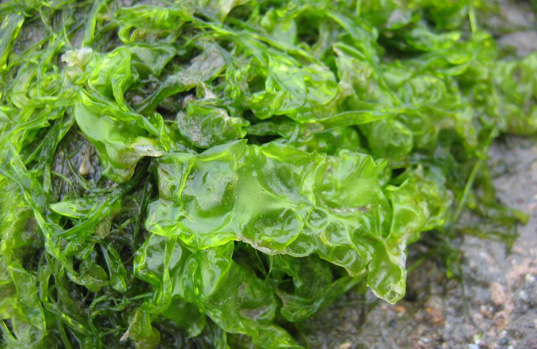
by Rick O'Connor | Feb 14, 2025
With this article we will shift from the microscopic creatures of the Gulf of Mexico to the macroscopic ones – ones you can see without a microscope. We will begin with the simplest and most primitive of macroscopic creatures – the seaweeds.
Many locals see the grass washed ashore along the Intracoastal Waterway and call this seaweed, but it is in fact seagrass. Seaweed differs from seagrass in that they are not true plants. True plants are vascular – meaning they have a series of “veins” running through their body called xylem and phloem. These veins move water and material throughout the body – similar to the arteries and veins of an animal. But seaweeds lack this “circulatory” system, rather they absorb water through their tissues and must live in the water environment to do this. Seaweeds lack leaves, stems, and roots. They do not produce seeds or flowers, but they do require sunlight and nutrients and conduct photosynthesis as true plants do. When I was in college seaweed was considered simple plants – just nonvascular ones. Today biologists believe they are too simple to be considered plants and thus are a group existing between the microscopic phytoplankton and the true vascular plants we know from our lawns and forests. They are often called algae as well as seaweed.

Mats of Sargassum on a south Florida Beach.
Photo: University of Florida
Biologists divided the seaweeds into divisions based on their color, which is determined by the photosynthetic pigments they have for photosynthesis. Compared to my college days, the classification of green algae is quite complex. The entire group was once placed in the Division Chlorophyta. Today, most sources consider only the marine forms of green algae in the group Chlorophyta, with numerous other groups consisting of thousands of species. Most green algae live in freshwater and are believed to be the group that led to the land plants we are familiar with. Their photosynthetic pigments include chlorophyll and a and b but also carotene and xanthophyll. The pigments are dominated by the chlorophylls – hence their green color – and the ratio of chlorophyll to carotene and xanthophyll is the same as the plants you find in your yard – hence the argument they led to the evolution of land plants.
Green algae – or any of the seaweeds – are not as common along the northern Gulf of Mexico as you find on other coasts. Not having true roots, stems, or leaves, seaweeds must attach themselves to the seafloor using a suction cup type structure called a holdfast. To attach, the holdfast must have a rock of some type. Along the rocky shores of Maine and California, they are quite common. Even with the limestone rock of south Florida you can find these. But the fine quartz sand of the northern Gulf of Mexico is not as inviting to them. That said, we do find them here and most are found on man-made structures such as jetties, seawalls, and artificial reefs – I found one attached to a beer can.
Of all of the green algae that exist in Florida, I have only encountered three. One is called “sea lettuce” in the genus Ulva. Attached to rock jetties and seawalls, it looks just like lettuce and is beautiful, brilliant green in color. It grows to about seven inches in height and is used as a food source in different countries. It can become a problem if local waters are high in nutrients due to pollution from land sources. It will grow abundantly, reducing habitat for other species, and wash ashore during storms where it breaks down releasing gases that can be toxic to shore life and humans. I first encountered it growing on the rock jetties at St. Andrews State Park in Panama City, but it does grow on local hard structures.

Sea Lettuce.
Photo: University of California
“Dead Man’s Fingers” – Codium – is another green algae I first encountered it on the jetties of St. Andrews. The thick finger-like projections of this seaweed extending from the rocks did resemble a glove – or the fingers of a dead man within the rocks. Some species around the world are used for food. But I could not find any references that it is here.
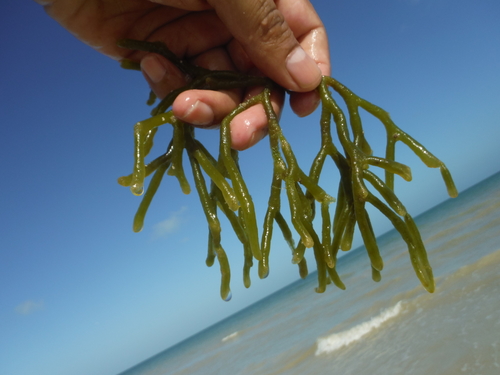
“Deadman’s Fingers”.
Photo: iNaturalist
The third species of green algae I have seen locally is known as the “Mermaids Wine Glass” – Acetabularia. This beautiful seaweed is relatively small and does resemble a wine, or martini glass. They are quite abundant in south Florida and is the one I found growing on a beer can submerged in Santa Rosa Sound.
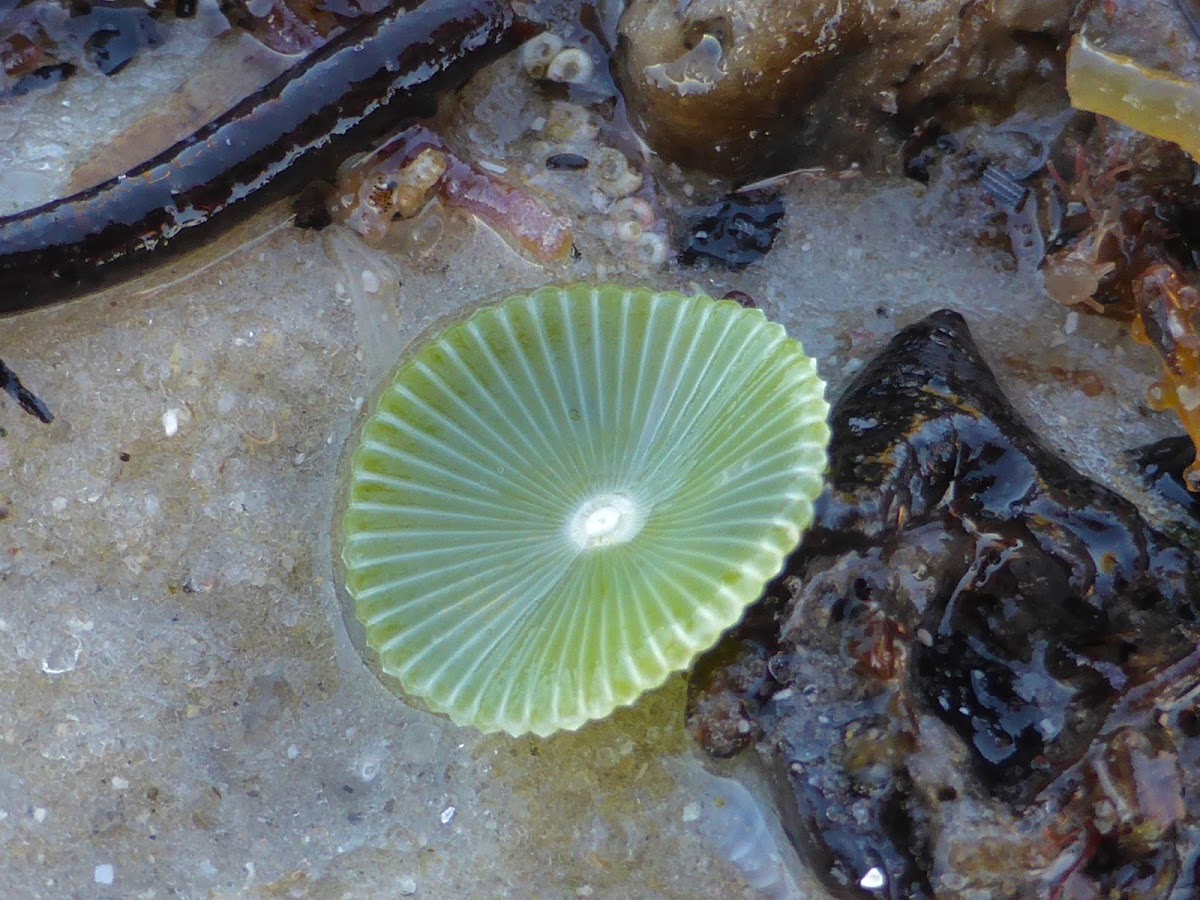
“Mermaid’s Wineglass”
Photo: Project Noah
Though seaweeds in general are harder to find along the northern Gulf coast, they are fun to search for and do play a role as primary producers here.
References
Green Algae. Wikipedia. https://en.wikipedia.org/wiki/Green_algae.
Deadman’s Fingers. Monterey Bay Aquarium. https://www.montereybayaquarium.org/animals/animals-a-to-z/dead-mans-fingers.
Introduction to Green Algae. University of California/Berkley. https://ucmp.berkeley.edu/greenalgae/greenalgae.html.
Ulva Lactuca. Wikipedia. https://en.wikipedia.org/wiki/Ulva_lactuca.
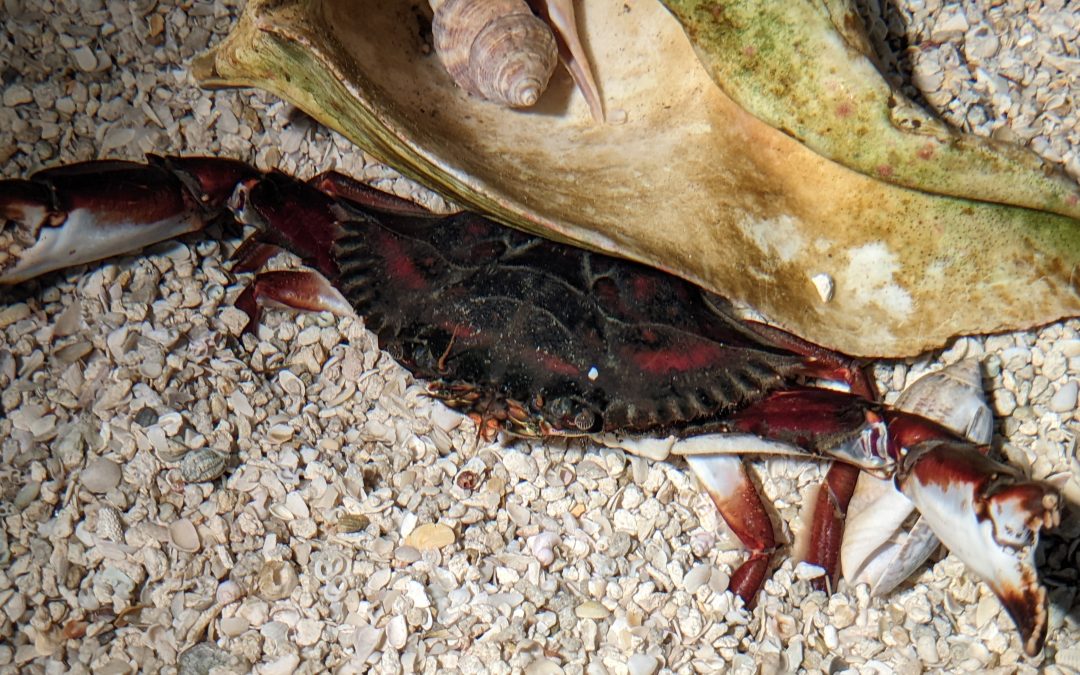
by Erik Lovestrand | Nov 22, 2024
In early November a local crabber, Kevin Martina, brought an interesting catch to the Franklin County Extension office in Apalachicola. Kevin and his brother Kenneth Martina fish for blue crabs in Apalachicola Bay and they came across what appeared at first glance to be a red-colored blue crab. In all their combined years of working crab pots, neither of them had seen a crab like this. On closer inspection at the Extension Office, there appeared to be some differences from a blue crab, other than the striking red coloration. It was the innate curiosity of our Extension Office Manager, Michelle Huber, that led us to the discovery that the crab was a species with a native range spanning Jamaica and Belize to Santa Caterina, Brazil. After Michelle showed photos of what she had found on her phone, we reached out to colleagues at the Apalachicola National Estuarine Research Reserve (ANERR) and told them we might have a Bocourt swimming crab (Callinectes bocourti). I told them that I could find no range maps indicating this species lived in our region. The nearest US Geological Survey data points for the species in the Gulf of Mexico were Alabama to the West and the Florida Everglades to the South. It was not long after the ANERR staff reached out to the Fish and Wildlife Conservation Commission that we received interest in confirming the identification and officially documenting the Bocourt swimming crab find.
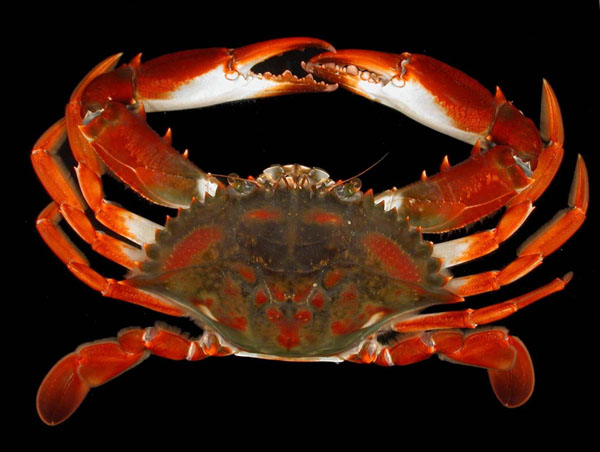
Bocourt Swimming Crab – USGS/South Carolina DNR
The first documented occurrence of a Bocourt swimming crab in the US happened in 1950 in South Florida. Since then, there have been rare finds in AL and MS and more common occurrences from South Florida all the way up to North Carolina on the Atlantic Coast. Theories about how they arrived include possible transport of larvae in ships’ ballast water or a natural expansion of range with the aid of various ocean currents like the Gulf Stream or by hitching a ride on floating debris from the Caribbean. Ecologically speaking, Bocourt crabs and our native blue crabs have virtually the same dietary habits and both species occur together throughout some parts of their native range. Even though there is likely some competition for food and refuge habitat, it doesn’t appear at this time that one of these crabs would dominate the ecosystem over the other. It also is not evident that Bocourt crabs are reproducing and established in the Northern Gulf of Mexico to-date.
If you are a commercial crabber in the Florida Panhandle, or happen to fish a few recreational traps, we would be interested to know if you have seen this species before. Location data and any good photos of specimens would go a long way to help monitor the species occurrence in our region. You can reach out to me at Elovestrand@ufl.edu or contact your local County Extension office to pass the info my way. Happy crabbing!
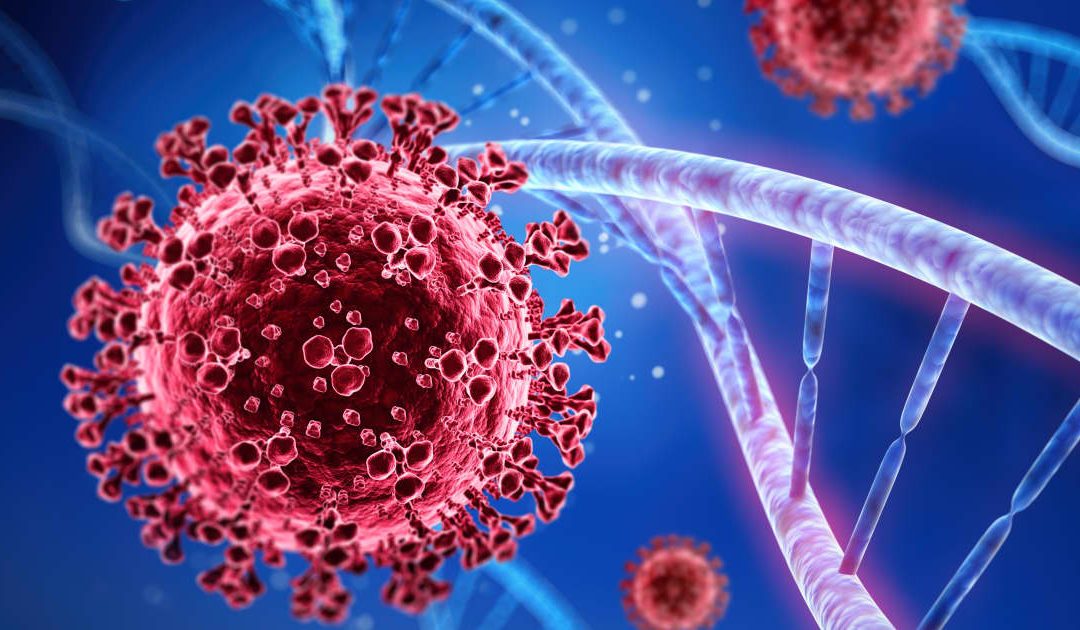
by Rick O'Connor | Oct 18, 2024
We are going to begin this series of articles with a “creature” that some do not consider alive – viruses. While studying marine science in college, and my early days as a marine science educator, there was a debate as to whether viruses were actually alive and should be included in a biology course. A quick glance at the textbooks of the time shows they were often omitted – though they were included in my microbiology class. Why were they omitted? Why did some consider them “non-living creatures”?

The coronavirus next to a strand of DNA.
Image: Florida International University.
Well, we always began biology 101 with the characteristics of life. Let’s scan these characteristics and see where viruses fit.
- Made of cells. This is not the case for viruses. A typical cell will include a cell membrane filled with cytoplasm and a nucleus, which is filled with genetic material (chromosomes containing DNA and RNA). An examination of a virus you will find it is either DNA or RNA encapsulated in a protein coat. It is “nucleus-like” in nature. Most cells run between 10-20 microns in size. A typical nucleus within a mammal cell will run between 5-10 microns. A typical virus would be 0.1 microns – these are tiny things – MUCH smaller than a cell.
- Process energy. Nope – they do not. Most cells utilize energy during their metabolism. Viruses do not do this.
- Growth and development. Nope again. They “spread”, which we discuss in a moment, but they do not grow. We are now 0-3.
- Homeostasis. Homeostasis is the movement of material and environmental control to remain stable – and viruses do not do this.
- Respond to stimuli. Yes… here is one they do. Studies show that viruses do respond to their chemical and physical environment.
- Metabolism. As mentioned above, this would be a no.
- Adaptation. Studies show that through very rapid reproduction they can adapt to the changing environment they are in.
- Reproduce. This is a sort of “yes/no” answer. They do reproduce (as we say – “spread”) but they do not do this on their own. They invade the nucleus within the cells of their host and replace their genetic material with that of the host creature. Then, during cell replication within the host, new viruses are produced and “spread”.
So, you can see why there is a debate. Of the eight common characteristics of life, viruses possess only three – and one of those can only be achieved with the assistance of a host creature. Now the question would be – do be labeled as a “creature” do you need ALL eight characteristics of life? Or only a few? And if only a few – how many? Because of this most biologists do not consider them alive.
During one class when we were discussing this a student made a comment – “don’t we KILL viruses? If so, then it must be alive first”. Point taken – and we should understand the phrase “kill a viruses” does not mean literally killing. It is a phrase we use. Though some argue we do kill viruses and thus…
Another point we could make here is that all life on the planet has been classified using a system developed by the Swedish botanist Carlos Linnaeus. Each creature is placed in a kingdom, then phylum, class, order, family, genus, and eventually a species name is given. We “name” the creature using its genus and species name – Homo sapiens for example. We do not see this for viruses.
All that said, both the National Oceanic and Atmospheric Administration and the National Institute of Health indicate the “most common form of life in the sea are viral-like particles” – with over 10 million in a single drop of seawater. We will leave the debate here. Your thoughts?
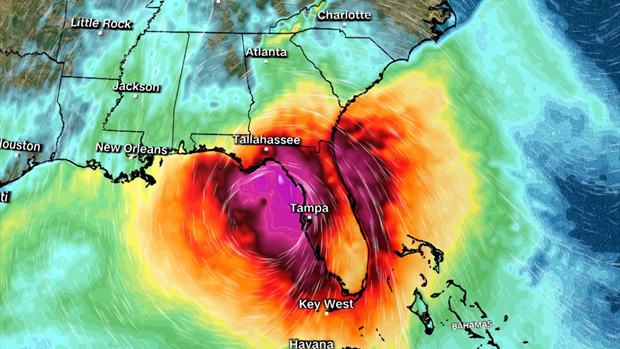
by Sheila Dunning | Oct 4, 2024
Coastal wetlands are some of the most ecologically productive environments on Earth. They support diverse plant and animal species, provide essential ecosystem services such as stormwater filtration, and act as buffers against storms. As Helene showed the Big Bend area, storm surge is devastating to these delicate ecosystems.

Hurricane Track on Wednesday evening.
As the force of rushing water erodes soil, uproots vegetation, and reshapes the landscape, critical habitats for wildlife, in and out of the water, is lost, sometimes, forever. Saltwater is forced into the freshwater wetlands. Many plants and aquatic animal species are not adapted to high salinity, and will die off. The ecosystem’s species composition can completely change in just a few short hours.
Prolonged storm surge can overwhelm even the very salt tolerant species. While wetlands are naturally adept at absorbing excess water, the salinity concentration change can lead to complete changes in soil chemistry, sediment build-up, and water oxygen levels. The biodiversity of plant and animal species will change in favor of marine species, versus freshwater species.
Coastal communities impacted by a hurricane change the view of the landscape for months, or even, years. Construction can replace many of the structures lost. Rebuilding wetlands can take hundreds of years. In the meantime, these developments remain even more vulnerable to the effects of the next storm. Apalachicola and Cedar Key are examples of the impacts of storm surge on coastal wetlands. Helene will do even more damage.
Many of the coastal cities in the Big Bend have been implementing mitigation strategies to reduce the damage. Extension agents throughout the area have utilized integrated approaches that combine natural and engineered solutions. Green Stormwater Infrastructure techniques and Living Shorelines are just two approaches being taken.
So, as we all wish them a speedy recovery, take some time to educate yourself on what could be done in all of our Panhandle coastal communities to protect our fragile wetland ecosystems. For more information go to:
https://ffl.ifas.ufl.edu/media/fflifasufledu/docs/gsi-documents/GSI-Maintenance-Manual.pdf
https://blogs.ifas.ufl.edu/news/2023/11/29/cedar-key-living-shorelines/
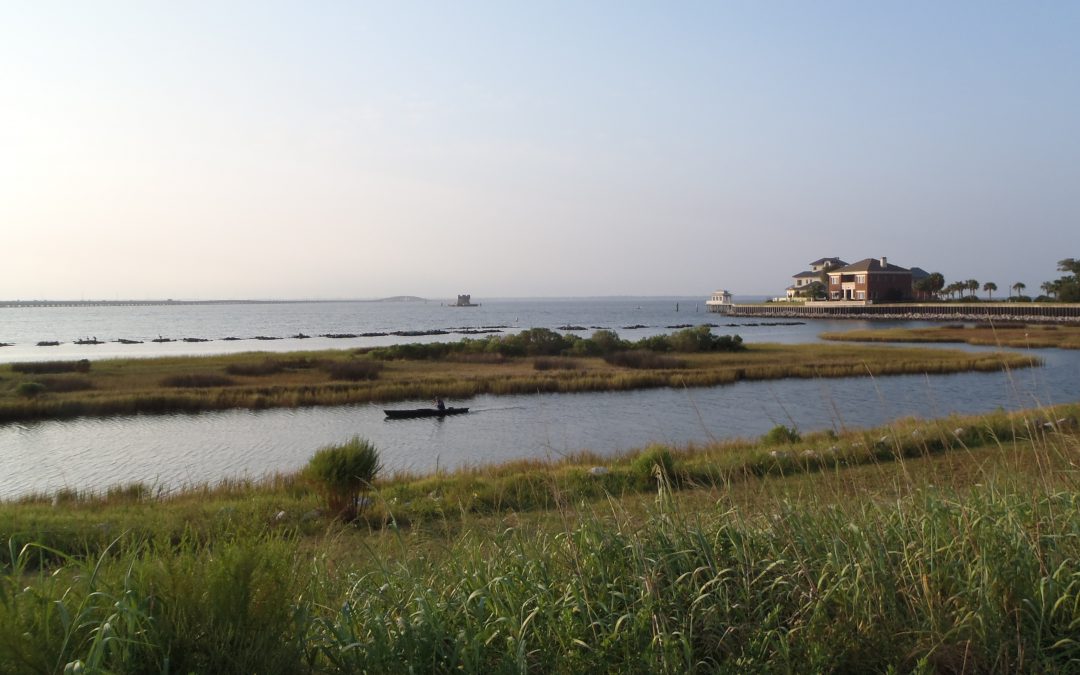
by Thomas Derbes II | Jun 21, 2024
In Part 1 of The Estuary’s Natural Filtration System article, we discussed the major contributors to natural filtration inside of the estuary. These examples included oysters, marsh plants, and seagrasses. In Part 2, we will discuss the smaller filter-feeding organisms including tunicates, barnacles, clams, and anemones.
Tunicates
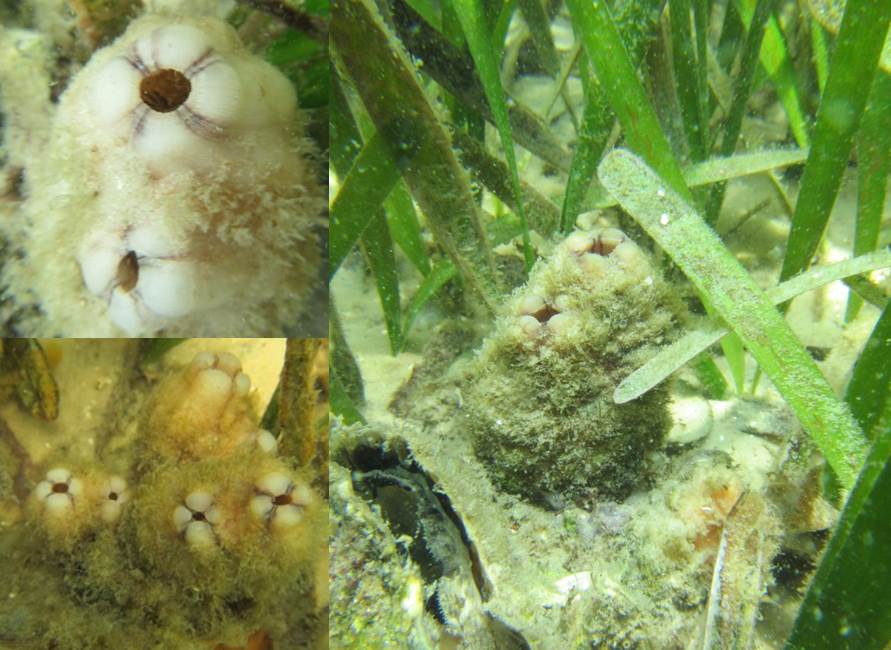
Pleated Sea Squirt – Photo Credit: Don Levitan, PH.D. FSU
Tunicates, also known as sea squirts, are very interesting marine invertebrates and can be easily confused for a sponge. There are many different types of tunicates in the estuaries and can be either solitary or colonial. You might’ve seen these at an aquarium attached to different substrates, and when removed from the water, their name sea squirt comes into play. Tunicates have a defense mechanism to shoot out the water inside their body in hopes of being released by any predator.
Tunicates are filter feeders and intake water through their inhalant siphons and expel waste and filtered water through their exhalant siphons. Tunicates can filter out phytoplankton, algae, detritus, and other suspended nutrients. The tunicate produces a mucus that catches these nutrients as it passes through, and the mucus is then conveyed to the intestine where it is digested and absorbed.
An invader to the Gulf of Mexico, the Pleated Sea Squirt (Styela plicata), hitched rides on the hulls of ships and found the Gulf of Mexico waters very favorable. You can sometimes spot these organisms on ropes that have been submerged for a long period of time in salty waters. Even though they are non-native, these sea squirts can filter, on average, 19 gallons of water per day.
Barnacles
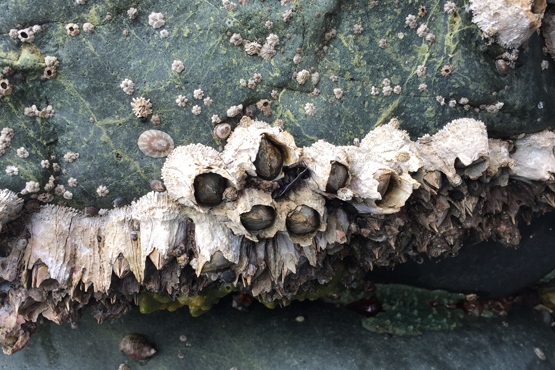
Barnacles along the seashore is a common site for many.
Photo: NOAA
One organism that seems ubiquitous worldwide is the barnacle (Genus Semibalanus and Genus Lepas). The Genus Semibalanus contains the common encrusting barnacle we are accustomed to seeing in our waterways along pilings, submerged rocks, and even other animals (turtles, whales, crabs, and oysters). The Genus Lepas contains Gooseneck Barnacles and can be seen attached to flotsam, floating organic debris, and other hard surfaces and have a stalk that attaches them to their substrate. Interesting fact, certain gooseneck barnacle species are eaten in different parts of the world.
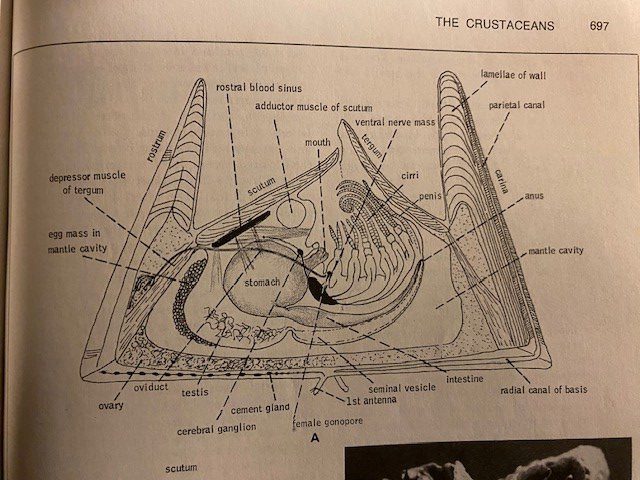
This image from a textbook shows the internal structure of a barnacle. Notice the shrimplike animal on its back with extendable appendages (cirri) for feeding.
Image: Robert Barnes Invertebrate Zoology.
Barnacles have over 2,100 species, are closely related to crabs and lobsters, and are a part of the subphylum Crustacea. At first glance, you might not think a barnacle is closely related to crabs, but when you remove the hard plates surrounding it, the body looks very similar to a crab. Barnacles also have life cycle stages that are similar to crabs; the nauplius and cyprid developmental stages. Inside of the hard plates is an organism with large feather-like appendages called cirri. When covered by water, the barnacles will extend their cirri into the water and trap microscopic particles like detritus, algae, and zooplankton. Barnacles are at the mercy of tides and currents, which makes quantifying their filtering ability difficult.
Hard Clams
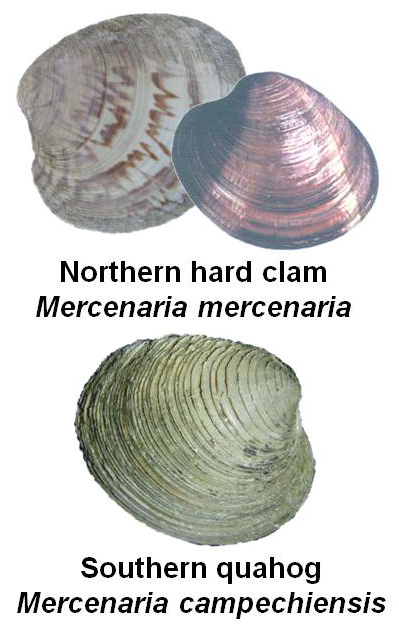
Clams of North Florida – UF/IFAS Shellfish
Even though not as abundant in the Florida Panhandle as they were in the 1970’s – 1980’s, hard clams (Mercenaria mercenaria and M. campechiensis) can still be found in the sand along the shoreline and near seagrass beds. These clams are also known as Quahogs and are in the family Veneridae, commonly known as the Venus clam family, and contain over 500 living species. Most of the clams in the family Veneridae are edible and Quahogs are the types of clams you would see in a clam chowder or clam bake.
Being the only bivalve on this list does not make it any less important than the oyster or scallop on Part 1’s list. In fact, a full-grown adult Southern Quahog clam can filter upwards of 20 gallons of water per day and have a lifespan of up to 30 years. Clams also live a much different lifestyle than their oyster and scallop cousins. Clams spend the majority of their life under the sand. Their movement under the sand helps aerate and mix the soil, which can sometimes stimulate seagrass growth.
Right outside the Florida Panhandle and in the Big Bend area, Quahog clams are commercially farmed in Cedar Key. Southern Quahog clams are also being used for restoration work in South Florida. Clams are being bred in a hatchery and their “seed” are being released into Sarasota Bay to help tackle the Red Tide (Karenia brevis) issue. According to the project’s website, they have added over 2 million clams since 2016, and the clams are filtering over 20 million gallons of seawater daily.
Anemones
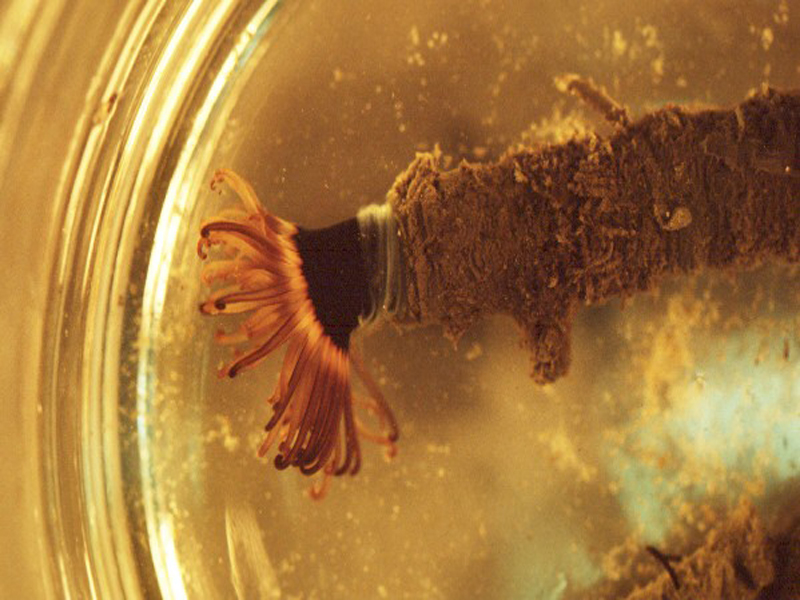
Tube-Dwelling Anemone Under Dissection Scope – UF/IFAS Shellfish
Anemones are beautiful Cnidarians resembling an upside-down, attached jellyfish, which couldn’t be closer to the truth. The phylum Cnidaria contains over 11,000 species of aquatic animals including corals, hydroids, sea anemones, and, you guessed it, jellyfish. Anemones come in many different shapes and sizes, but the common estuary anemones include the tube-dwelling anemone (Ceriantheopsis americana) and the tricolor anemone (Calliactis tricolor), also known as the hitchhiking anemone. If you have ever owned a saltwater aquarium, you might have run into the pest anemone Aiptasia (Aiptasia sp.).
Anemones filter feed with their tentacles by catching plankton, detritus, and other nutrients as the tide and current flows. The tentacles of the anemone are lined with cnidocytes that contain small amounts of poison that will stun or paralyze the prey. The cnidae are triggered to release when an organism touches the tentacles. If the anemone is successful in immobilizing the prey, the anemone will guide the prey to their mouth with the tentacles. Just like the barnacle, anemones are at the mercy of the tides and currents, and filtration rates are hard to calculate. However, if you ever see an anemone with food around, they move those tentacles to and from their mouths quickly and constantly!
In Parting
As you can see, there are many different natural filters in our estuary. Healthy, efficiently filtering estuaries are very important for the local community and the quality of the waters we love and enjoy. For more information on our watersheds and estuaries and how to protect them, visit Sea Grant’s Guide To Estuary-Friendly Living.
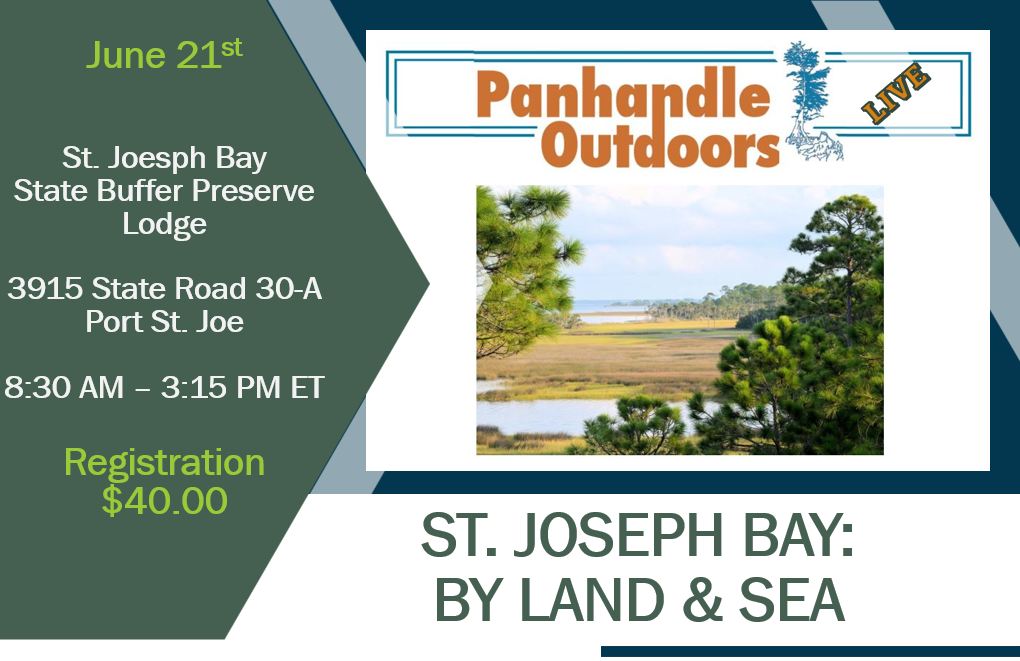
by Ray Bodrey | Jun 3, 2024
The University of Florida/IFAS Extension & Florida Sea Grant faculty are reintroducing their acclaimed “Panhandle Outdoors LIVE!” series on St. Joseph Bay. This ecosystem is home to some of the richest concentrations of flora and fauna on the Northern Gulf Coast. This area supports an amazing diversity of fish, aquatic invertebrates, turtles and other species of the marsh and pine flatwoods. Come learn about the important roles of ecosystem!
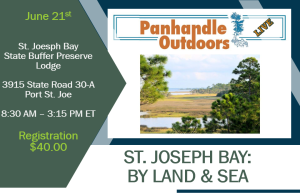
Registration fee is $40. You must pre-register to attend.
Registration link: https://www.eventbrite.com/e/panhandle-outdoors-live-st-joseph-bay-by-land-sea-tickets-906983109897
or use the QR code:
Meals: Lunch, drinks & snacks provided (you may bring your own)
Attire: outdoor wear, water shoes, bug spray and sunscreen
*If afternoon rain is in forecast, outdoor activities may be switched to the morning schedule
Held at the St. Joseph Bay State Buffer Preserve Lodge: 3915 State Road 30-A, Port St. Joe
| 8:30 – 8:35 Welcome & Introduction – Ray Bodrey, Gulf County Extension (5 min) |
| 8:35 – 9:20 Diamondback Terrapin Ecology – Rick O’Connor, Escambia County Extension |
| 9:20 – 10:05 Exploring Snakes, Lizards & the Cuban Tree Frog – Erik Lovestrand, Franklin County Extension |
| 10:05 – 10:15 Break |
| 10:15 – 11:00 The Bay Scallop & Habitat – Ray Bodrey, Gulf County Extension |
| 11:00 – 11:45 The Hard Structures: Artificial Reefs & Derelict Vessel Program – Scott Jackson, Bay County Extension |
| 11:45 – Noon Question & Answer Session – All Agents |
| Noon – 1:00 Pizza & Salad! |
| 1:00 – 1:20 Introduction to the Buffer & History – Buffer Preserve Staff |
| 1:20 – 2:20 Tram Tour – Buffer Preserve Staff |
| 2:20 – 2:30 Break |
| 2:30 – 3:00 A Walk in the Mangroves – All Agents |
| 3:00 – 3:15 Wrap up & Adjourn – All |


















